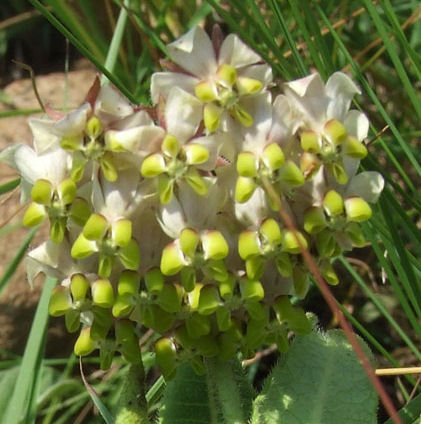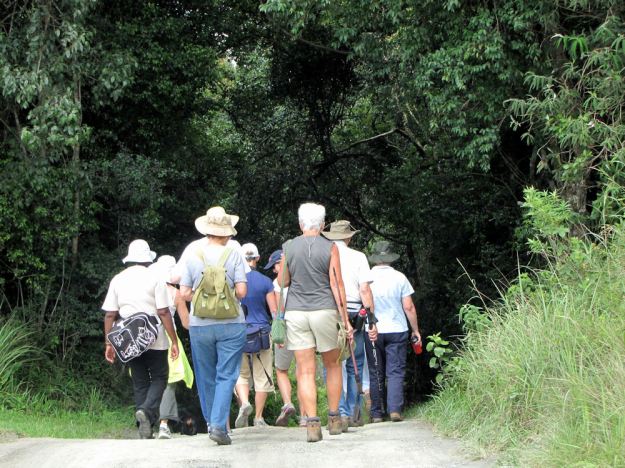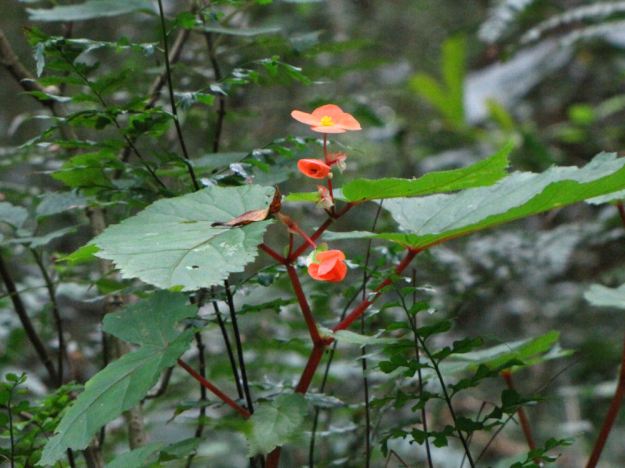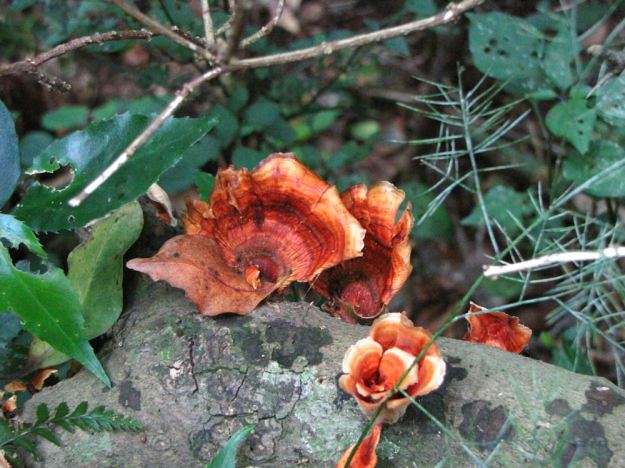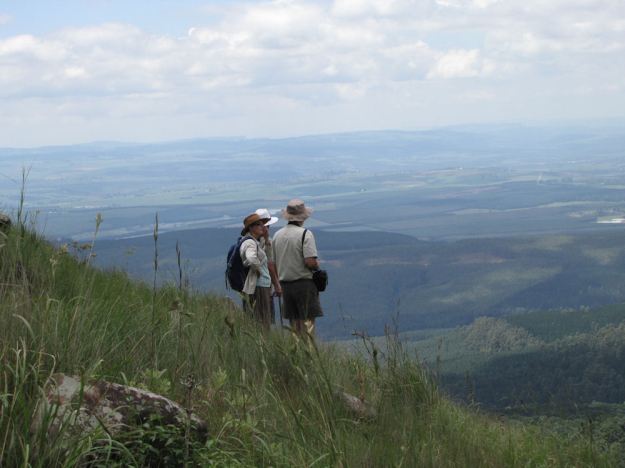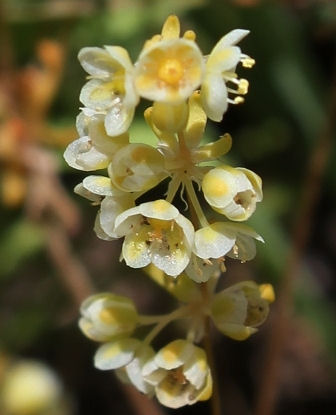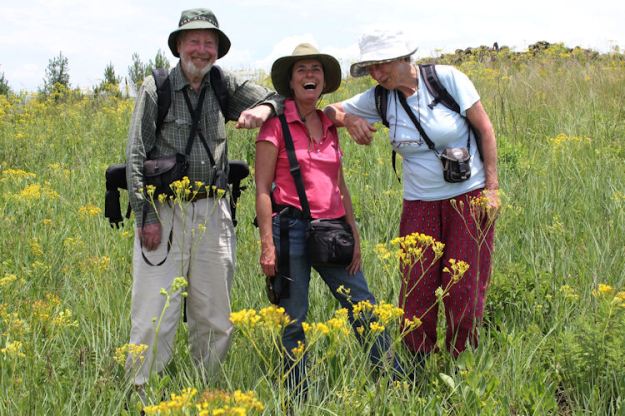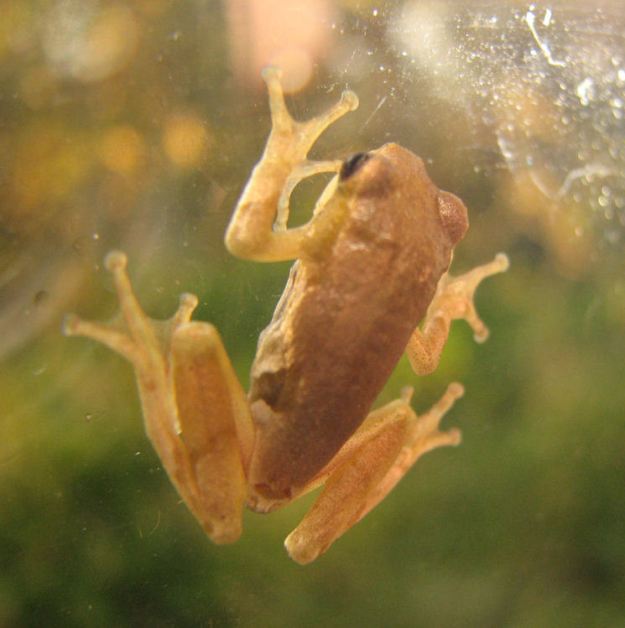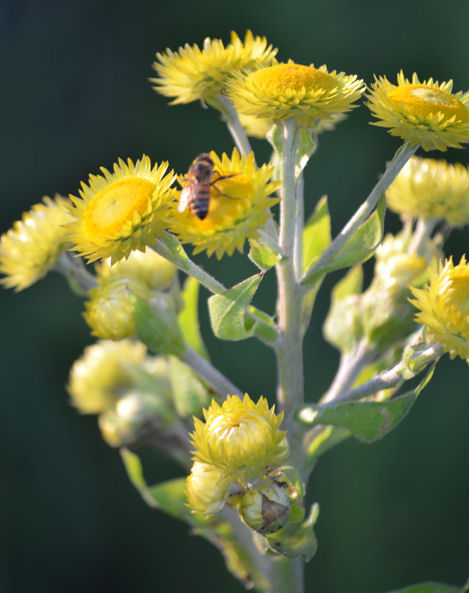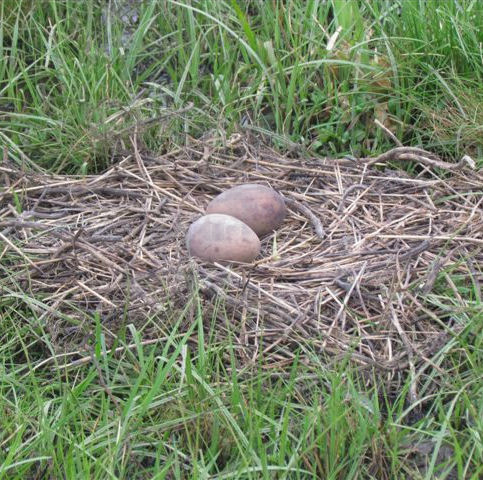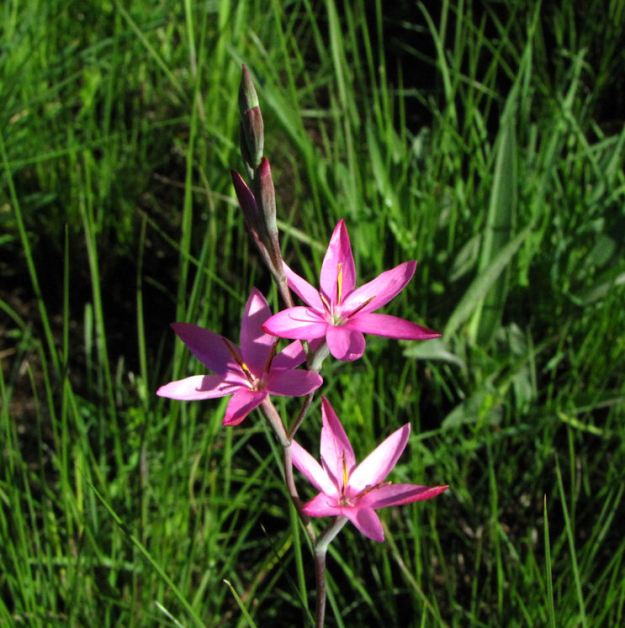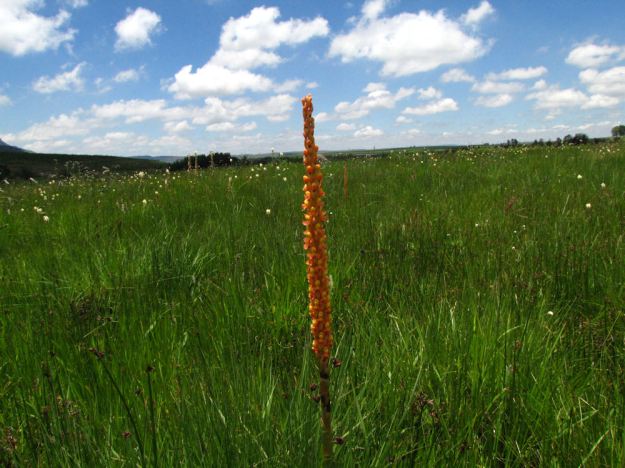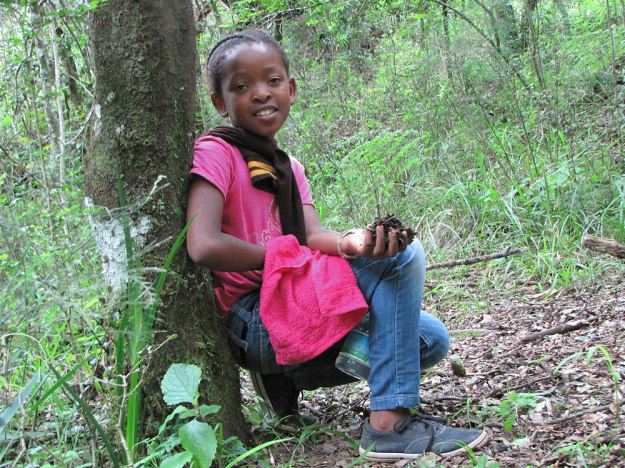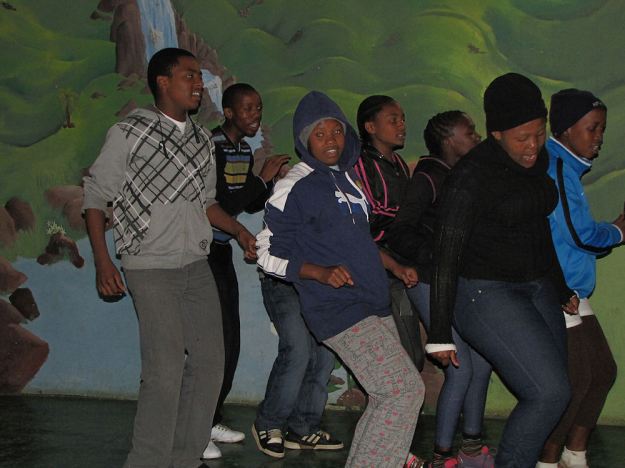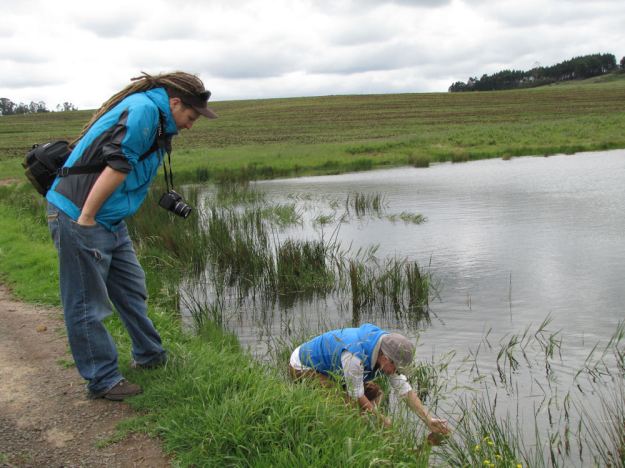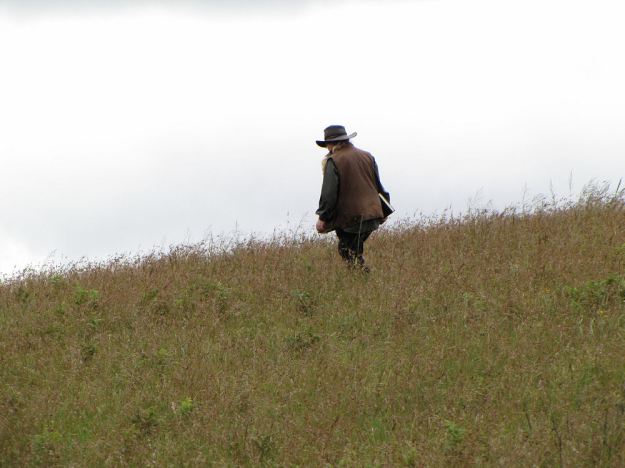Barry and Kirsten Cromhout of “Highland Gl:
Pair of Yellow-billed Ducks with nest on upper dam, across the Dargle road.
Basil and Terry Cuthbert of Jaluka Estate:
Knysna Turaco on “Forest Dew”. After snowfall in September, one perished from conditions at the time
Trevor and Cheryl Scheepers of Lapa Lapa:
Pied crow robbed all the eggs from two domestic hens’ nests, stream from the dam on Harmony has numbers of small fish, some of which get stranded by the water level dropping.
Neil and Gail Baxter of Mosgate:
November 7 – at 9 am on the west side of a patch of indigenous bush at the foot of Edgeware, Neil was walking when he startled a Serval at a place where the bush meets the grasslands. The Serval was large in size. It fled.
Barbara and David Clulow of The Willows:
The ongoing life-story of the five Grey Crowned Cranes. Last summer the parents raised three chicks at the dam on The Drift; they fly off now each day, feed, and return at night to their old home territory – the dam. Each day we see them during our evening walk.- November 5, a very misty time, roosting in the Willow tree on the island in the dam- up top, amongst the Cattle Egrets and Cormorants

Nov 10 – a swarm of bees chose rather close quarters, below a grapevine, for comfort, so a call to Trevor Scheepers, whose hives were full, resulted in Gavin Phoenix arriving properly clad for the task, and the swarm was hived off to Trinity forest, where we hope the workers and their Queen will live a honeyed existence.

November 13 – on the hillside near Impendle Nature Reserve at 1410 m; 29 39 38.8s 29 53 42.05e
A group of Schizoglossum nitidum on a hillside heavily covered with a variety of wildflowers
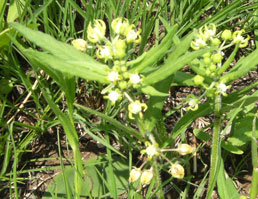
Schizoglossum nitidum

Gnidia kraussiana
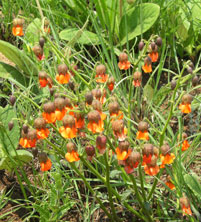
Hermannia cristata
November 16 – a Burchell’s Coucal heard at long last; Grey Crowned Cranes on nest site in wetland on The Willows again, daily.
Rob Speirs, Peter Geldart and Barry Cromhout report seeing a Crowned Hornbill, flying over The Rockeries. This is an extension recently of the Hornbill’s known area.
George Edlmann on Parkside:
Five Fork-tailed Drongos have been dive bombing a pair of Cape Crows at their nest high in the old oak tree near the house. The Crows held their ground near their nest by ducking and complaining with groans at the attacks, but the assaults were regular and in quick succession – for all of four minutes. Growing in the pasture not far from the Parkside house are numbers of Starflowers, or Stinkhorns, a type of fungus. Some have been 130 to 150mm from point to point.
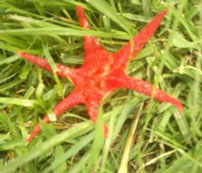
Another interesting visitor – a large Landsnail.
 Pete and Frances Nel of Four Gates:
Pete and Frances Nel of Four Gates:
Two Southern Ground Hornbills on two occasions near the house; once seen by Des Muller, who was there on 17 November, and again by Frances on 22 November.
Crystelle Wilson Of Gramarye:

Not only are most of the migrant birds back for their summer sojourn, but November is also a hive of breeding activity. Nests are completed, cuckoos and other parasites take their chances of slipping eggs into those of host species and fledglings are fed by hard-working parents.
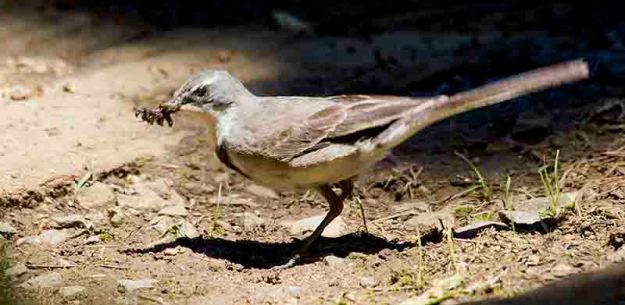
The SABAP2 list for the Elandshoek pentad is: Olive Thrush, Pin-tailed Whydah, Hadeda Ibis, Cape Robin-Chat, Black Saw-wing, Greater Striped-Swallow, Speckled Mousebird, Dark-capped Bulbul, Cape White-eye, Fork-tailed Drongo, Little Rush-Warbler, Cape Sparrow, Cape Canary, Cape Turtle Dove, Red-eyed Dove, Red-necked Spurfowl, Amethyst Sunbird, Long-crested Eagle, Red-chested Flufftail, Diderick Cuckoo, Fan-tailed Widowbird, Drakensberg Prinia, African Hoopoe, Dark-capped Yellow Warbler, African Reed-Warbler, African Paradise-Flycatcher,
Buff-spotted Flufftail, Helmeted Guineafowl, Cape Glossy Starling, Southern Boubou, Grey Crowned Crane, Cattle Egret, Reed Cormorant, White-breasted Cormorant, Little Grebe, Red-knobbed Coot, Southern Greyheaded Sparrow, Giant Kingfisher, Yellow-billed Kite, Common Fiscal, Cape Wagtail,
Yellow-billed Duck, African Pipit, African Quailfinch, Cape Longclaw, African Stonechat, Cape Weaver,
Blacksmith Lapwing, Red-collared Widowbird, Red-billed Quelea, Common Waxbill, Southern Red Bishop, Brown-throated Martin, Le Vaillant’s Cisticola, Village Weaver, Black-headed Heron, House Sparrow, Bokmakierie, White-throated Swallow, Pied Crow, Cape Crow, Barn Swallow, Common Quail,
Cape Grassbird, Jackal Buzzard, Pied Kingfisher, Zitting Cisticola, Barratt’s Warbler, African Fish-Eagle,
Brown-hooded Kingfisher, African Rail, African Snipe, Speckled Pigeon, Black-shouldered Kite, African Black Swift, African Black Duck, Yellow-fronted Canary, White Stork, Malachite Sunbird, Wailing Cisticola, Common Swift, Horus Swift, Red-chested Cuckoo, Black Cuckoo, Sombre Greenbul, Southern Double-collared Sunbird, Bar-throated Apalis, Forest Canary, Wattled Crane, Long-tailed Widowbird, Pale-crowned Cisticola, Olive Bush-Shrike, Cape Batis.
Edgeware Hill Wildflower Climb:
The official outing on 1 November was washed out, but a replacement flower hunt took place on 25 November, when the flowers were superb. At 1312 m altitude five plants with this blue flower, unknown so far, below
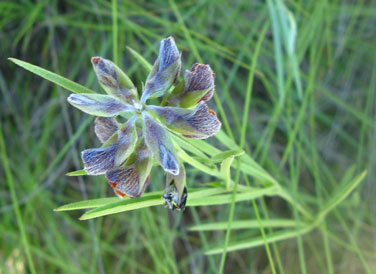
A very special find was this flower below, identified by David Styles using Plant Chat – at 1400 m altitude – Hybanthus capensis

Bruce and Bev Astrup of Highland Glen:
Malachite Kingfisher, Red-necked Spurfowl, Fork-tail Drongo, Speckled Mousebird, Giant Kingfisher, two Spotted Eagle-Owls, Grey Crowned Cranes, Black-headed Oriole, Green Wood-Hoopoe, African Harrier-Hawk (Gymnogene), Long-crested Eagle (who tackled an old wooden stump, and lodged a piece of wood in its talons – much shaking and biting by bill, till at long last, relief), Hadedah Ibis, two Egyptian Geese, who rule the lands near the river, Little Rush-Warbler, Village Weaver, Common Fiscal, Dark-capped Bulbul, Yellow-billed Ducks, Cattle Egrets, Southern Red Bishop, Helmeted Guineafowl.
Scrub Hare; Long-tailed Grey Mongoose, frustrated in effort to dine on domestic fowl.
Philip and Christeen Grant of Sitamani:
A special sighting in November was a Serval just behind the house. It was totally unaware of me, circled round like a domestic cat in the tall grass, then lay down for a nap!
The birds have been lovely, particularly the dawn chorus; and many fungi and ferns brought forth by the wonderful rain. But my main focus is a two hour walk through a wonderland of Spring flowers on the 4 November when I saw 52 different flowers and two firsts for Sitamani amongst them, Rhodohypoxis baurii and Streptocarpus pusillus, in a very rocky, mini-cliff area in the dolorite on the hillside.
The other flowers seen were: Aspidonepsis diploglossa & flava, Eriosema kraussianum, Lotononis corymbosa, Ajuga orphrydis, Nemesia caerulea, Pentanisia augustifolia, Aster bakeriannus, Sutera floribunda, Vernonia natalensis & a smaller sp., Gerbera piloselloides, Alepidia natalensis, Albuca pachychlamys, Sisyranthus trichostomus, Kniphofia brachstachya,

Walhenbergia krebsii, Lobelia erinus, Hirpicium armerioides, Scabiosa columbaria, Cyphia elata, Berkheya macrocephala, Watsonia socium, Peucedanum caffrum, Anemone fanninii (flowers over but a strong growth of leaves), Raphionacme hirsuta, Polygala sp., Clutia cordata, Eulophia clavicornis, Gazania krebsiana, Berkheya setifera, Indigofera tristis & velutina, Senecio coronatus, Dimorphotheca jucunda, Diclis reptans, Epilobium capense, Eriosema distinctum, Ledebouria ovatifolia plus two other sp.,

Haemanthus humilis, Hypoxis parvula & argentea, Senecio oxyriifolius, Pelargonium alchemilloides, Cerastium arabidis, Stachys aethiopica, Hermannia woodii, Schistostephium hetalobum, Dierama pictum, Monopsis decipiens!
Remember ‘Bossy Boston’, the tiny Grey Crowned Crane chick, rescued on the lawn at Highland Glen last February?
A note received on 7 December from Tanya Smith: “Bossy Boston is doing well at Hlatikulu Crane and Wetland Sanctuary. He is free flying and comes and goes as he pleases but spends most of his time with the kids at the education centre there. He is a huge hit with all visitors and is playing a massive role in the education programme, which Hlatikulu sanctuary facilitates. He is flying the flag high for all cranes! I think he was destined to become an ambassador for crane conservation. It would be great if you guys could get there one of these days to visit him. Oh, and he even accompanies the Working for Wetland team members into the wetland there to oversee their work and ensure they do a good job rehabilitating wetlands for his fellow wild cranes!”
Nikki Brighton took 24 students there last week and agrees that Bossy is doing great PR for Cranes. “I never thought I could be so close to this beautiful bird” said Nondumiso Mabhida.
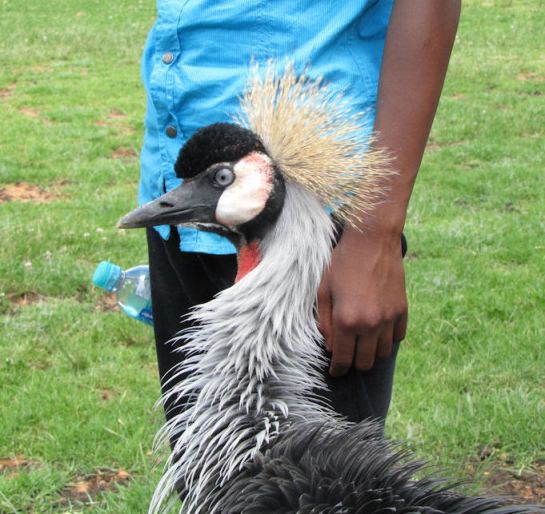
The Source of the Msunduzi river – a viewpoint
As one drives along the R617 from Boston towards Pietermaritzburg, one passes the turnoff to Rossi, then the turnoff to Nonchesa, takes the sharp corner and drives downhill and through Mafakathini; between the 22 km marker and that for 23 kms is a spring from which the locals derive much water, collecting it in drums, carting it on wheelbarrows. This is the source of the Msunduze., into which many dozens of streamlets flow, from this hillside, & from north of Maswazini, & from north of the Holy Family Convent at Elandskop, & from Elandskop itself, from the Mbumbane area, & from the Nomo area, joined by the Nkobongwana river from south-east of Mafakathini, then joined by the Nhlambamasoka river at Taylor’s Halt, through the mudflats of Henley Dam to Pietermaritzburg itself.
Impendle Nature Reserve – a Draft ‘Protected Area Management Plan’
Prepared by Ezemvelo, this Draft Plan is a major step in proposals to take the Reserve forward. It is available at suitable Libraries and Municipal Offices. The document is 132 pages in length and 5.6 Mbs to download. By way of providing a small flavour of this document, but without any of the detail, here is an exerpt, namely page 29:
STRATEGIC MANAGEMENT FRAMEWORK
In an effort to ensure that Impendle Nature Reserve is effectively managed, the following strategic framework has been developed. It is aimed at providing the strategic basis for the protection, development and operation of the nature reserve over the next five years and has been prepared collaboratively through a process involving stakeholders within Ezemvelo KZN Wildlife, the communities around the nature reserve, local and provincial government departments and other stakeholders. The vision describes the overall long-term goal for the operation, protection and development of Impendle Nature Reserve. The objectives and strategic outcomes that follow are intended to provide the basis for the achievement of the vision. The objectives provide a broad description of the goals for each key performance area. The strategic outcomes, which flow from the objectives, set out what is needed to achieve the objectives, based on the management challenges, issues and opportunities described in Section 2 above.
3.1 Impendle Nature Reserve vision
A reserve that protects the ecosystem integrity and important biodiversity of the area, provides a sustainable flow of eco-system services and is managed effectively with the support of the community This vision of Impendle nature reserve includes the effective management of the reserve that incorporates the reserve having adequate resources. The community support is an important component of management and includes not only regular open channels of communication but also an extensive environmental awareness component as reflected in the objectives and in the management tables. An effectively managed reserve also incorporate the potential economic opportunities that need to be investigated as per the management objectives and management tables.
3.2 Objectives and strategic outcomes.
An objective has been identified for each of Impendle Nature Reserve key performance areas, which follow from the management challenges, issues and opportunities, and relate to the important functions and activities necessary to protect, develop and manage it effectively. The objectives have then been translated into strategic outcomes, which form the basis for the management activities and targets set out in the operational management framework, described in Section 6 below. Table 3.1 sets out the key performance areas, the objective for each key performance area and the strategic outcomes, required to realise the objectives.




